This
is an exciting trip to one of the least visited parts of the Arctic
National Wildlife Refuge. Participants on this trip should be prepared
for a real Alaska adventure. The rugged mountainous terrain and unpredictable
headwaters of the Canning River demand a certain toughness and
willingness to experience nature on 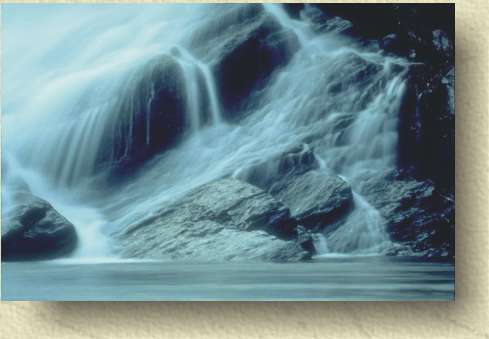 her terms. However, the wild beauty
of this region and the abundance of animal life will reward those who
come along. From it's headwaters on the northern Continental Divide, we
will float this river of surprises to
her terms. However, the wild beauty
of this region and the abundance of animal life will reward those who
come along. From it's headwaters on the northern Continental Divide, we
will float this river of surprises to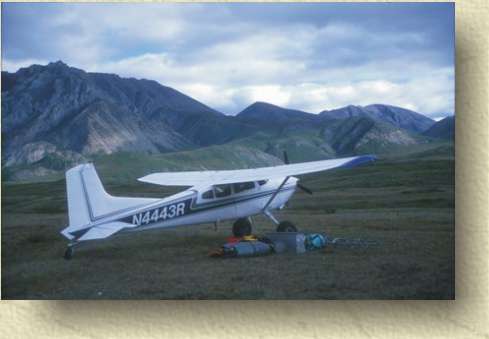 the coastal plain of Alaskaís
North Slope.
The adventure begins when our Cessna 185 carries us through some very
rugged and remote mountain passes in the eastern Brooks Range then comes
in for a landing on a rugged tundra airstrip in a high mountain valley. Using small
rafts and inflatable canoes or kayaks, we will start the journey on the Marsh
Fork of the Canning River.
the coastal plain of Alaskaís
North Slope.
The adventure begins when our Cessna 185 carries us through some very
rugged and remote mountain passes in the eastern Brooks Range then comes
in for a landing on a rugged tundra airstrip in a high mountain valley. Using small
rafts and inflatable canoes or kayaks, we will start the journey on the Marsh
Fork of the Canning River.
During the first two thirds of the trip, the river carries us through an
extreme landscape of abrupt mountains and vistas. Truly, this is some of
the most spectacular mountain scenery in all of Alaska. The surrounding
Franklin Mountains are sheer, craggy and accentuated by massive strata
layers. The 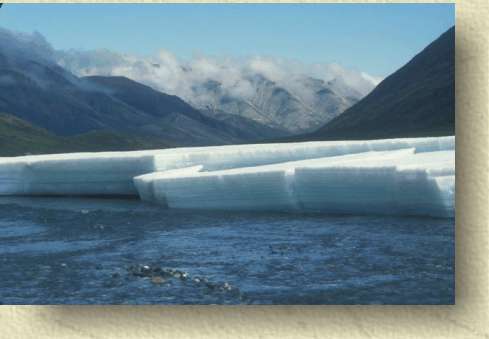 powerful
tectonic forces that uplifted these mountains are evident in the
tortured rock walls. The upper section of the river is characterized by
shallow braided streams. Route finding through these rivulets is key and
we will often have to get out of the boats to pull it through shallow
sections. The water of the Marsh Fork is typically gin-clear and icy
cold. In many places the river will be covered with beautiful blue
aufeis - thick river ice that is formed
powerful
tectonic forces that uplifted these mountains are evident in the
tortured rock walls. The upper section of the river is characterized by
shallow braided streams. Route finding through these rivulets is key and
we will often have to get out of the boats to pull it through shallow
sections. The water of the Marsh Fork is typically gin-clear and icy
cold. In many places the river will be covered with beautiful blue
aufeis - thick river ice that is formed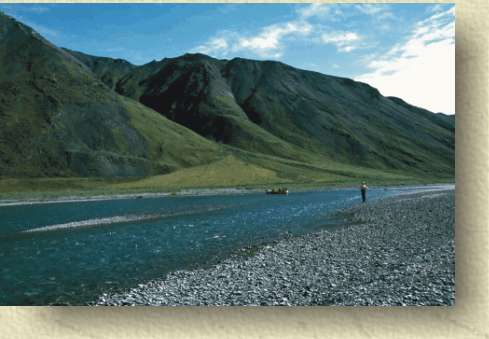 through repeated cycles of river
overflow and freezing creating dense, layered ice walls. In some
sections the river will be hemmed in by the aufeis creating ice canyons
that are lovely and intriguing but can be treacherous. Dallís sheep are
abundant on the ridges above the Marsh Fork and are often seen at salt licks along the river.
From every one of our camps along this stretch of river, the hiking is
superb. As this area is so seldom traveled, we will literally be
exploring the region any time we hike into the mountains. A sharp eye
may reward the observer with very interesting fossil discoveries, sightings of
wolves, grizzlies, and other wildlife, and some stunning photographs.
through repeated cycles of river
overflow and freezing creating dense, layered ice walls. In some
sections the river will be hemmed in by the aufeis creating ice canyons
that are lovely and intriguing but can be treacherous. Dallís sheep are
abundant on the ridges above the Marsh Fork and are often seen at salt licks along the river.
From every one of our camps along this stretch of river, the hiking is
superb. As this area is so seldom traveled, we will literally be
exploring the region any time we hike into the mountains. A sharp eye
may reward the observer with very interesting fossil discoveries, sightings of
wolves, grizzlies, and other wildlife, and some stunning photographs.
The
Marsh Fork flows out of a mountain gorge and suddenly merges with the
Canning River. Here the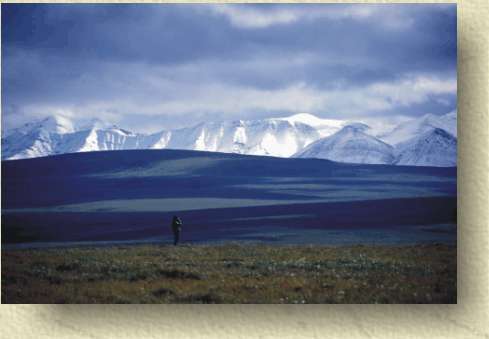 landscape changes and the terrain begins to open
up. The craggy mountains along the Marsh Fork give way to the lovely
Shublik Mountains. The river widens. Marshes, small lakes and tundra
benches and plateaus are found on both sides of the river, but the high
mountains are not far off. Caribou herds will be a common sight on
tundra hills on this stretch of river and grizzly bears and wolves may
be seen along the river banks or among the caribou. The Shubliks give
way to the Sadlerochit Mountains and they roll down to the coastal
plain.
landscape changes and the terrain begins to open
up. The craggy mountains along the Marsh Fork give way to the lovely
Shublik Mountains. The river widens. Marshes, small lakes and tundra
benches and plateaus are found on both sides of the river, but the high
mountains are not far off. Caribou herds will be a common sight on
tundra hills on this stretch of river and grizzly bears and wolves may
be seen along the river banks or among the caribou. The Shubliks give
way to the Sadlerochit Mountains and they roll down to the coastal
plain.
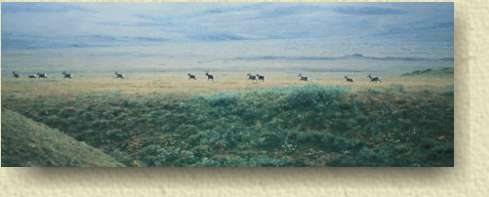 The last third of the trip is a naturalistís bonanza. As we float
through the northern foothills on to the coastal plain, we will see
increasing numbers of birds, caribou, and grizzlies. The tundra has an
abundance of wild flowers and we will encounter numerous nesting birds
on the tundra and along the ponds and marshes. We will especially be
watching for that great survivor of the ice ages - the musk ox. The area
between the Canning River and the Sadlerochit River to the East is the
best musk ox habitat in Alaska. It is not unusual to see large herds up
to 20 animals or more.
The last third of the trip is a naturalistís bonanza. As we float
through the northern foothills on to the coastal plain, we will see
increasing numbers of birds, caribou, and grizzlies. The tundra has an
abundance of wild flowers and we will encounter numerous nesting birds
on the tundra and along the ponds and marshes. We will especially be
watching for that great survivor of the ice ages - the musk ox. The area
between the Canning River and the Sadlerochit River to the East is the
best musk ox habitat in Alaska. It is not unusual to see large herds up
to 20 animals or more.
Fishermen on this river in late July and August will be equally excited
by the large and beautiful arctic charr. Few rivers in Alaska can match
the Canning for the size and abundance of these fighting fish. When we
aren't catching charr, grayling will be in abundance and easy to hook.
Anyone wishing to fish will need a valid Alaska fishing license
available in Fairbanks.
 ROUTE:
The trip beings in Fairbanks with a 90
minute charter flight to the Yukon River village of Ft.Yukon. From here
we will load up smaller wheeled planes for the flight to the
remote Athabascan community of Arctic Village. Smaller Cessna 185s will
meet us here and begin ferrying all people and gear 60 minutes to a
gravel bar on the upper reaches of the Marsh Fork - the headwaters of
the Canning River. We start our Arctic river
voyage at an altitude of about 2400 ft. Rafting the Marsh Fork and The
Canning rivers, we will end our journey at the Canning River Delta near
the Arctic Ocean at about 350 ft. elevation traveling about 90 river
miles. The upper waters of the Marsh Fork will be shallow and may
require us to drag the boats or even portage them through rocky shoals.
For the first 6 days, mountains as high as 7000 feet tower over our
small river valley. The mountains almost abruptly give way to graceful
tundra hills which mellow into the rolling coastal plain.
From a small rocky bench alongside the river, DeHavilland beavers will
ferry our group to an oilfield camp on the Kavik River. A dual engine
Caravan will carry us back to Fairbanks.
ROUTE:
The trip beings in Fairbanks with a 90
minute charter flight to the Yukon River village of Ft.Yukon. From here
we will load up smaller wheeled planes for the flight to the
remote Athabascan community of Arctic Village. Smaller Cessna 185s will
meet us here and begin ferrying all people and gear 60 minutes to a
gravel bar on the upper reaches of the Marsh Fork - the headwaters of
the Canning River. We start our Arctic river
voyage at an altitude of about 2400 ft. Rafting the Marsh Fork and The
Canning rivers, we will end our journey at the Canning River Delta near
the Arctic Ocean at about 350 ft. elevation traveling about 90 river
miles. The upper waters of the Marsh Fork will be shallow and may
require us to drag the boats or even portage them through rocky shoals.
For the first 6 days, mountains as high as 7000 feet tower over our
small river valley. The mountains almost abruptly give way to graceful
tundra hills which mellow into the rolling coastal plain.
From a small rocky bench alongside the river, DeHavilland beavers will
ferry our group to an oilfield camp on the Kavik River. A dual engine
Caravan will carry us back to Fairbanks.
WEATHER:
Climatically, the northern Brooks
Range and Arctic Slope are considered arid. Unfortunately, most of its 5
- 6 inches of annual precipitation comes in the 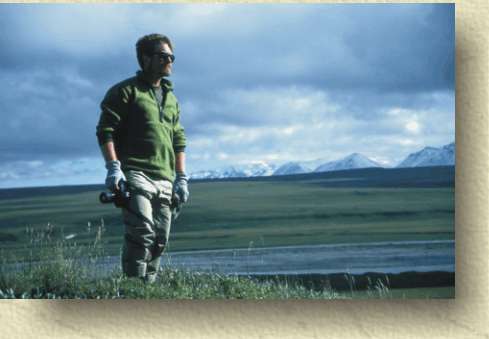 summer as rain with an
occasional snow squall possible. We can expect one third of the trip to
be wet, mostly in the form of drizzle; another third will be dry but
overcast; and last, the much anticipated third, sunshine. Temperatures
can range from 25 to 60 degrees F. Wind from the South or North can be
quite violent. Low lying fog further into the trip usually burns off by
late morning. A very big advantage is the nearly 24 hours of daylight.
With proper planning and flexibility, we can maximize our travel or
hiking time regardless of weather conditions.
summer as rain with an
occasional snow squall possible. We can expect one third of the trip to
be wet, mostly in the form of drizzle; another third will be dry but
overcast; and last, the much anticipated third, sunshine. Temperatures
can range from 25 to 60 degrees F. Wind from the South or North can be
quite violent. Low lying fog further into the trip usually burns off by
late morning. A very big advantage is the nearly 24 hours of daylight.
With proper planning and flexibility, we can maximize our travel or
hiking time regardless of weather conditions.
FLORA:
The plant life on this trip is
representative of alpine/arctic tundra. This miniature ecosystem is as
interesting and diverse as any in the world. In June and July the
tundra is covered with blooming arctic poppies, Kamchatka rhododendron,
fireweed, louseworts, oxytrope, composites, and saxifrages. By August
most of the flowers with the exception of poppys, fireweed, and asters,
have faded but the tundra is not any less colorful; the willows have
begun to take on a golden color and the tundra is splashed with red from
the autumn colors of the blueberry and bearberry. Throughout the summer
the cotton sedge will give the marshes a blush of white.
 FAUNA:
The
ever present caribou and the magnificent musk ox will top our list of
mammals we will see. Other large mammals we will see will be Dallís
sheep in the mountains, grizzlies, moose, and
with
luck wolves and wolverines. The raptors in this area include the rough
legged hawk, gyrfalcon, golden eagle, merlin, peregrine falcon, and
several types of owl. There
are over one hundred species of birds among which are the jaeger, willow
ptarmigan, and numerous shore birds and water fowl. The fish population
consists primarily of grayling and arctic char.
FAUNA:
The
ever present caribou and the magnificent musk ox will top our list of
mammals we will see. Other large mammals we will see will be Dallís
sheep in the mountains, grizzlies, moose, and
with
luck wolves and wolverines. The raptors in this area include the rough
legged hawk, gyrfalcon, golden eagle, merlin, peregrine falcon, and
several types of owl. There
are over one hundred species of birds among which are the jaeger, willow
ptarmigan, and numerous shore birds and water fowl. The fish population
consists primarily of grayling and arctic char.
 her terms. However, the wild beauty
of this region and the abundance of animal life will reward those who
come along. From it's headwaters on the northern Continental Divide, we
will float this river of surprises to
her terms. However, the wild beauty
of this region and the abundance of animal life will reward those who
come along. From it's headwaters on the northern Continental Divide, we
will float this river of surprises to the coastal plain of Alaskaís
North Slope.
The adventure begins when our Cessna 185 carries us through some very
rugged and remote mountain passes in the eastern Brooks Range then comes
in for a landing on a rugged tundra airstrip in a high mountain valley. Using small
rafts and inflatable canoes or kayaks, we will start the journey on the Marsh
Fork of the Canning River.
the coastal plain of Alaskaís
North Slope.
The adventure begins when our Cessna 185 carries us through some very
rugged and remote mountain passes in the eastern Brooks Range then comes
in for a landing on a rugged tundra airstrip in a high mountain valley. Using small
rafts and inflatable canoes or kayaks, we will start the journey on the Marsh
Fork of the Canning River.


 The last third of the trip is a naturalistís bonanza. As we float
through the northern foothills on to the coastal plain, we will see
increasing numbers of birds, caribou, and grizzlies. The tundra has an
abundance of wild flowers and we will encounter numerous nesting birds
on the tundra and along the ponds and marshes. We will especially be
watching for that great survivor of the ice ages - the musk ox. The area
between the Canning River and the Sadlerochit River to the East is the
best musk ox habitat in Alaska. It is not unusual to see large herds up
to 20 animals or more.
The last third of the trip is a naturalistís bonanza. As we float
through the northern foothills on to the coastal plain, we will see
increasing numbers of birds, caribou, and grizzlies. The tundra has an
abundance of wild flowers and we will encounter numerous nesting birds
on the tundra and along the ponds and marshes. We will especially be
watching for that great survivor of the ice ages - the musk ox. The area
between the Canning River and the Sadlerochit River to the East is the
best musk ox habitat in Alaska. It is not unusual to see large herds up
to 20 animals or more.

